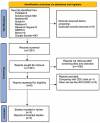Comparison of Indonesian Growth Reference Chart and World Health Organization Child Growth Standard in Detecting Stunting: A Systematic Review and Meta-analysis of 15,874 Children
- PMID: 34866369
- PMCID: PMC8900070
- DOI: 10.4274/jcrpe.galenos.2021.2021-8-12
Comparison of Indonesian Growth Reference Chart and World Health Organization Child Growth Standard in Detecting Stunting: A Systematic Review and Meta-analysis of 15,874 Children
Abstract
Recognition of an overestimation of stunted children in Indonesia when using the World Health Organization Child Growth Standards (WHOCGS) led to the creation of the Indonesian Growth Reference Chart (IGRC) in 2005, with further improvement in 2018. This systematic review aimed to determine whether there is a difference in the diagnosis of stunting when using these two charts. This systematic review is registered in the PROSPERO database (CRD42021259934). Literature research was performed on PubMed, Science Direct, Medline, Scielo, Medrxiv, Research Square, SSRN, and Biorxiv to identify studies published from 2018 onwards that examined the comparison of IGRC and WHOCGS in detecting stunting. Three studies were included in this review. Pooled analysis showed that IGRC resulted in a lower prevalence of stunted and severely stunted children [risk ratio (RR): 0.28 (95% confidence intervals (CI): 0.15-0.51), p<0.0001, I2=97%]. Comparison between IGRC and WHOGCS for prevalence of normal height children showed that there was no difference, and this finding was not significant [RR: 1.56 (95% CI: 0.92-2.66), p=0.1, I2=100%], and the comparison for prevalence of tall children also showed that there was no difference when using IGRC or WHOGCS, and this finding was also insignificant [RR: 2.02 (95% CI: 0.78-5.20), p=0.14, I2=98%]. This meta-analysis showed that stunted and severely stunted Indonesian children are over-represented using WHOCGS. The difference between IGRC and WHOCGS has occurred because of the sample population, as IGRC includes children from all 33 provinces in Indonesia, better reflecting the growth of all children in Indonesia.
Keywords: Indonesian Growth Reference Chart; WHO Growth Chart; stunting.
Figures


Similar articles
-
Indonesian National Growth Reference Charts Better Reflect Height and Weight of Children in West Java, Indonesia, than WHO Child Growth Standards.J Clin Res Pediatr Endocrinol. 2020 Nov 25;12(4):410-419. doi: 10.4274/jcrpe.galenos.2020.2020.0044. Epub 2020 Aug 10. J Clin Res Pediatr Endocrinol. 2020. PMID: 32772522 Free PMC article.
-
Comparison of WHO growth standard and national Indonesian growth reference in determining prevalence and determinants of stunting and underweight in children under five: a cross-sectional study from Musi sub-district.F1000Res. 2020 May 4;9:324. doi: 10.12688/f1000research.23156.4. eCollection 2020. F1000Res. 2020. PMID: 32551096 Free PMC article.
-
Stunting coexisting with overweight in 2·0-4·9-year-old Indonesian children: prevalence, trends and associated risk factors from repeated cross-sectional surveys.Public Health Nutr. 2016 Oct;19(15):2698-707. doi: 10.1017/S1368980016000926. Epub 2016 Apr 28. Public Health Nutr. 2016. PMID: 27120968 Free PMC article.
-
A review of child stunting determinants in Indonesia.Matern Child Nutr. 2018 Oct;14(4):e12617. doi: 10.1111/mcn.12617. Epub 2018 May 17. Matern Child Nutr. 2018. PMID: 29770565 Free PMC article.
-
Boys are more stunted than girls in sub-Saharan Africa: a meta-analysis of 16 demographic and health surveys.BMC Pediatr. 2007 Apr 10;7:17. doi: 10.1186/1471-2431-7-17. BMC Pediatr. 2007. PMID: 17425787 Free PMC article. Review.
Cited by
-
The effect of early childhood stature on later cognitive functions in Indonesian adolescents: comparation using the National growth reference and the WHO growth standard.BMC Pediatr. 2025 Jun 7;25(1):466. doi: 10.1186/s12887-025-05829-9. BMC Pediatr. 2025. PMID: 40483390 Free PMC article.
References
-
- United Nations Children’s Fund. Nutrition Capacity Assessment in Indonesia: UNICEF;2018. Last Accessed Date: 2021 August 1. Available from: [Internet] https://www.unicef.org/indonesia/media/1816/file/Nutrition%20Assessment%....
-
- Kementerian Kesehatan Republik Indonesia. Laporan Kinerja Kementerian Kesehatan Tahun 2020: Kementerian Kesehatan Republik Indonesia;2021. Last Accessed Date: 2021 August 1. Available from: [Internet] http://ppid.kemkes.go.id/uploads/img_60e3c13edba9f.pdf.
-
- Scheffler C, Hermanussen M, Bogin B, Liana DS, Taolin F, Cempaka PMVP, Irawan M, Ibbibah LF, Mappapa NK, Payong MKE, Homalessy AV, Takalapeta A, Apriyanti S, Manoeroe MG, Dupe FR, Ratri RRK, Touw SY, K PV, Murtani BJ, Nunuhitu R, Puspitasari R, Riandra IK, Liwan AS, Amandari P, Permatasari AAI, Julia M, Batubara J, Pulungan A. Stunting is not a synonym of malnutrition. Eur J Clin Nutr. 2020;74:377–386. - PubMed
-
- Julia M, van Weissenbruch MM, Prawirohartono EP, Surjono A, Delemarre-van de Waal HA. Tracking for underweight, overweight and obesity from childhood to adolescence: a 5-year follow-up study in urban Indonesian children. Horm Res. 2008;69:301–306. - PubMed
Publication types
MeSH terms
LinkOut - more resources
Full Text Sources
Medical
